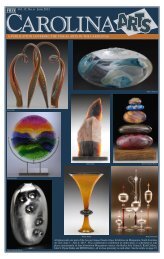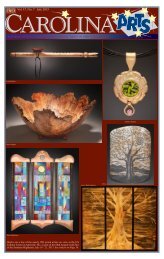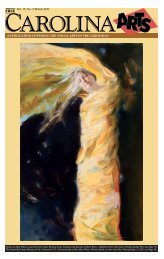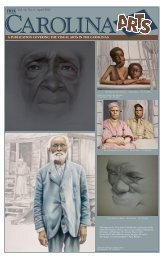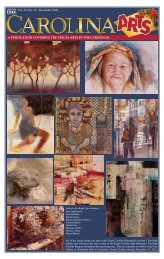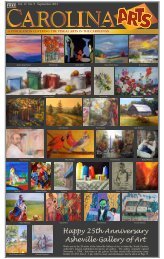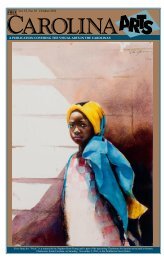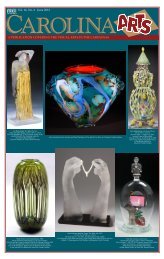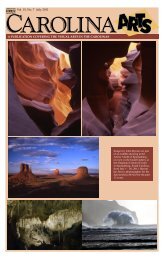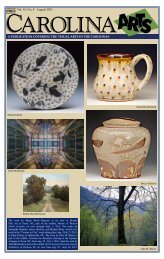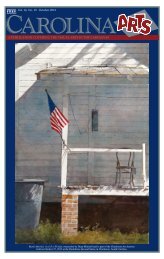Vol. 15, No. 1 January 2011 - Carolina Arts
Vol. 15, No. 1 January 2011 - Carolina Arts
Vol. 15, No. 1 January 2011 - Carolina Arts
Create successful ePaper yourself
Turn your PDF publications into a flip-book with our unique Google optimized e-Paper software.
Waterworks Visual <strong>Arts</strong> Centercontinued from Page 21of traditional media – sewing, embroidery, andcrocheting.”Barry Russell offered the following statementon his wood turnings: “I am a self-taughtwood turner. I have not attended any formalschool to learn the basics of woodturning, butI have met, worked with, hosted in my home,and discussed my work with many nationallyrecognized wood turners and have attendeddemonstrations and workshop. The artists thathave influenced me the most have been mostlyin approach and attitude rather than object specific.They have given me insights and encouragementto follow my own path. Woodturningon the lathe easily lends itself to the creation ofvessels, but the vessel is only the beginning. Iseek to use classic forms as a starting point. Iam challenged by a beautiful and unique materialthat can be formed to create a work thathonors the beauty of wood and the elegance ofform, and at the same time, I am challenged topresent a piece that transforms the vessel into aunique object. I employ carving, sculpting, texturing,burning, and coloring to create a workproduct that has a visual and tactile impact onthose who come in contact with it.”Jenny Lou Sherburne offered the followingabout her works: “I believe that life is agift. Making pots is my way of celebrating andmaintaining this belief. The creative processcompels me to listen to an inner voice - myintuition - which, in turn, provides me cluesabout how to live my life. My inspirationsrange from garlic cloves to onion domes, fromthe Isle of Crete to the Land of Oz, and fromAntonio Gaudi to Dr. Seuss. I see beauty, humor,and vigor everywhere, and I try to createpots that embody these values. The cross-pollinationbetween my life and work nourishesboth as I strive to communicate a world viewof wonder, curiosity, and joy.”First known for her landscape paintings ofcedar trees, Cindy Taplin more recently hasfocused on paintings of buildings, especiallythose of landmarks in downtown Winston-Salem, NC. She tells how her ‘building series’began in a somewhat accidental way. “I waswalking around downtown and just seeing allthese cool places, and I think part of it is themath thing in me, too. I love all the old factorybuildings around here.”“I think I’ve figured out that you try a littlebit of everything, and then suddenly one dayit’s like, oh, this is what I’m actually good at!I’m always looking for light and dark,” addsTaplin. “I’m always looking for, like, that oneshadow there on that green building; that’scontinued from Page 13Melissa Earley: 10+ (A Decade ofBeadwork and Other Art) is an exhibitionof beadwork and paintings spanningmore than a decade and highlighting themost significant works from the career ofEarley. Known for her beadwork whichmerges an ancient Native American beadweaving technique with original, contemporaryimagery, Earley grew up inCharleston, SC, and has been living andworking in Spartanburg, SC, since 2000.She studied drawing and printmakingat the College of Charleston, where shereceived a BA in Studio Art.Earley began working with beads over<strong>15</strong> years ago as an independent jewelrydesigner and was soon studying traditionalNative America loom weaving techniques.She incorporated her own paintings anddrawings into small beaded pieces, andover the course of the following years,began learning off-loom stitches and expandingher works into much larger, threedimensional pieces.About her work, Earley says, “Thecommon theme is introspection. For me,making art is basically a form of therapy,a way of examining my own psyche,sometimes exorcising some demons, andcommunicating my thoughts, feelings andexperiences to others.”Despite the often bright colors andseemingly whimsical images in much ofher work, much of the work does examinedifficult themes, such as illness anddeath. Earley explains, “Grief is one ofthose experiences that we all share, andwhat drew me to that. With the whole series,though, I was thinking more about gettingpeople to look at things that they walk byevery day. I’m not trying to make any hugestatement; I just want people to see things theway that I see them. The shadows – they getme every time!”And, finally Jane Woodward offers thesewords about her oil paintings: “From a gradeschool kid with the excitement of a new boxof crayons to an adult with her first tiny set ofoil paints, my passion has always been aboutcolor and the anticipation of creating! Mybackground as an Interior Designer further focusedmy interest in architecture, composition,color, and texture. These elements become thefoundation of my paintings. Uniting my love ofarchitecture with photography, I often composemy paintings on camera. My frequent answerto ‘What do you paint?’ is ‘architectural elements’.The fluid movement of oils helps toachieve a distinctive architectural viewpointwith a unique design perspective.”“My current body of work, entitled, Forthe Love of Italy, is taken from personalphotographs from a recent expedition in pleinair paintings in Tuscany,” added Woodward.“Combined with visits to Rome and Florence,the inspiration of Italy continues to inspireme.”The Waterworks Visual <strong>Arts</strong> Center wantsto thank its advocates: F & M Bank, The lateKatharine W. Osborne, and James G. and thelate Christine P. Whitton.The Waterworks Visual <strong>Arts</strong> Center isaccredited by the American Association ofMuseums. Its mission is to provide diverseopportunities in the arts for all people throughexhibitions, education, and outreach. TheWaterworks is funded by individual memberships,corporations and businesses, foundations,the City of Salisbury, Rowan County,and the Rowan <strong>Arts</strong> Council. The Instituteof Museum and Library Sciences, a federalgrant-making agency dedicated to creatingand sustaining a nation of learners by helpinglibraries and museums serve their communities,supports the Center. Waterworks receivesgeneral support from the <strong>No</strong>rth <strong>Carolina</strong> <strong>Arts</strong>Council, an agency of the Department of CulturalResources and the National Endowmentfor the <strong>Arts</strong>, which believes that a great nationdeserves great art.For further information check our NCInstitutional Gallery listings, call the Center at704/636-1882 or visit (www.waterworks.org).Pickens County Museum of Artyet there is still something of a taboo intalking about it publicly. Emotional painmakes others uncomfortable and keeps ussomewhat relegated to the outside untilwe ‘get over it’. And yet it’s absolutelynatural and very necessary to the healingprocess, so I wanted to bring it out intothe light and share my experience with theviewer, with the hope that we will bothfeeling less alone.”Earley’s work can be found in privateand corporate collections across the country.She has participated in exhibitions inDallas, Denver, and across the Southeast,receiving numerous awards and grants.She is proud to be an original memberof CAFfeine Contemporary Art Forum,based in upstate South <strong>Carolina</strong>.The final featured exhibition is BarbaraSt Denis: Mixed Media. St. Denis,living in Easley, SC, is a signature memberof the Georgia Watercolor Society andthe Southern Watercolor Society. She isalso a member in Excellence of the South<strong>Carolina</strong> Watermedia Society. In 1976, sheestablished The Art Emporium, a retail artstore & gallery that she owns in Easley,SC.Over the years St. Denis has receivednumerous awards and has been includedin a wide variety of invitational exhibitions.Her work has been covered severaltimes in publications such as CreativeWatercolor, Best of Watercolor <strong>Vol</strong>umeIII, Best of Watercolor Painting Color,Creative Watercolor and in Mary Toddcontinued above on next column to the rightKaitlyn watercolor 16" x 20"Annette Ragone HallCommissioned Portraits in Oil,Watercolor, Pastel, and CharcoalBeam’s Celebrate Your Creative Self. In2008, St. Denis was invited to paint aChristmas ornament for one of the WhiteHouse Christmas trees, which remains inits permanent Washington, DC, collection.Speaking about her work, St. Denissays, “Color, design, the figure, buildingsand inanimate objects are the primaryelements of my paintings. Symbols andshapes which represent my personalartistic journey, i.e. my fascination withclocks and numbers, enable me to tell mystory without portraying the final chapter.These elements are painted in watercolor,acrylic, and/or other water based materialsin an abstract format.” She added,“Watermedia has been my medium ofFRANK, the Franklin Street <strong>Arts</strong>Collective in Chapel Hill, NC, will present,Seeing the Figure, an exhibition ofcontemporary work inspired by the humanform, on view from Jan. 10 through Mar.6, <strong>2011</strong>. An opening reception will be heldon Jan. 14, <strong>2011</strong>, from 7-9pm.Headlined by invited artists DennisFarber and Connie Imboden from Baltimore,MD, as well as Triangle area artistsParis Alexander and Laura Farrow, theshow will also contain juried work fromour FRANK member artists. The showwill be juried by celebrated artist BeverlyMcIver.The exhibiting artists have varied approachesto the figure in style, medium,and content. Describing the work of ourinvited artist, Connie Imboden, Carl Littlein Art New England Magazine said, “Imboden’sstature as a world-class photographeris based on her compelling imagesof bodies transformed by water. Over theyears she has explored the intersection ofphysical form and liquid medium. In herphotographs, torsos, limbs, and visagesstretch and twist into new configurationsthat are often gorgeous and frequentlydisturbing.”AnnetteRagoneHall.com704-798-9400 annette@annettehall.comAnnette’s studio is located in theRail Walk <strong>Arts</strong> District in Salisbury, NC.choice since the early 1980’s. Prior to thattime, starting in 1963, I worked in oil, penand ink and pastels. Most recently I haveincluded found collage elements in muchof my work. I am an emotional painterand it is my desire to convey that idea tothe viewer.”The Pickens County Museum of Art& History is funded in part by PickensCounty, members and friends of the museumand a grant from the South <strong>Carolina</strong><strong>Arts</strong> Commission, which receives supportfrom the National Endowment for the <strong>Arts</strong>.For further information check our SCInstitutional Gallery listings or call theMuseum at 864/898-5963.FRANK in Chapel Hill, NC,Features Figure ExhibitionSpeaking of Alexander Paris, Dr. LawrenceJ. Wheeler, Director of the NC Museumof Art, said, “Paris uses the humanform as his subject, frequently in carvedstone, but also in clay and hard plaster. Heexpresses himself equally well in all thesematerials. In fact these varied elementscontribute to the power of his art.”Our invited artists have pieces in significantnational and international collectionsranging from the Museum of ModernArt in New York to the MetropolitanMuseum of Photography in Tokyo, andmany of our FRANK artists are collectedregionally and nationally.Seeing the Figure is sponsored by 140West and Whitehall Antiques, and is coordinatedby member artists Paul Hrusovsky,Marianita Stevans, and BarbaraTyroler.Also on view at FRANK through Jan.9, <strong>2011</strong>, is the exhibit, Small Wonders,featuring small works by gallery memberartists.The mission of the Franklin Street <strong>Arts</strong>Collective is to support the arts communityof Chapel Hill and the region,expand community appreciation of thecontinued on Page 24<strong>Carolina</strong> <strong>Arts</strong>, <strong>January</strong> <strong>2011</strong> - Page 23



